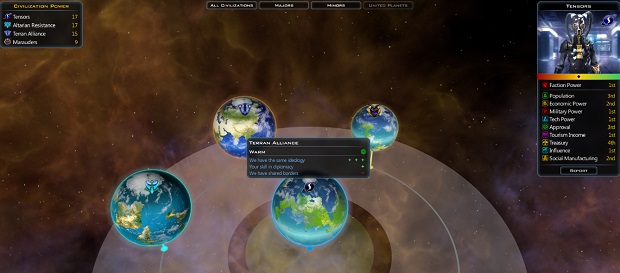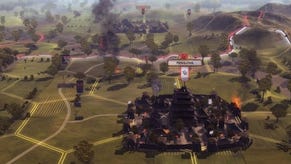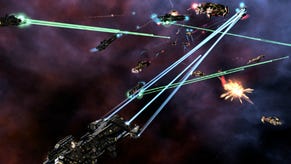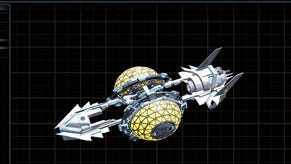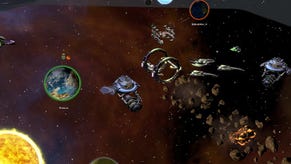Wot I Think: Galactic Civilizations III
Stellar?
Galactic Civilizations III [official site] is the long-awaited sequel to the 24th best strategy game of all time. I've spent a week looking to the stars and planting my flag in every planet in sight in order to understand the changes that have been made, and the improvements and failures at the heart of this behemoth. Here's wot I think.
In the perfect 4X game, whether set in a hobbity shire or in the spaces between the stars, you always feel that there are several valid options at the start of each turn. The decisions might be monumental, leading to long-term game-changing diversions, such as declarations of war or the construction of a unique building or colony. They might also be of limited consequence, cosmetic even, but it's important that they exist and that you feel your actions are either defining the character of your civilisation or its place in the world.
Galactic Civilizations III often feels like a small step forward for Stardock's excellent sci-fi 4X series. There are new resources to gather, new galactic 'terrain' features, changes to ship construction and design, and tweaks to the handling of the tech tree. The moral alignment of your civ has been jettisoned, replaced with a three-way ideology system that presents a more compelling set of choices whenever colonisation or random galactic events occur. Online multiplayer is included. Maps can be absolutely gigantic, with over 100 competing races scattered across them.
If I had to pick a stand-out feature, the one I'd slap front and centre on an imaginary marketing campaign, it'd be those map sizes. They're preposterous and the decision to give players the ability to pack such enormous galaxies with starfaring species is bold. The size and specifics of the galaxy you're playing in mark the first big decision you'll make when starting a game of GalCiv III. It might be the most important decision of all because playing on a small or medium map is a completely different experience to the eventual micromanagement mire of the largest simulations.
I always rush toward the biggest possible map when I'm playing a new strategy game. A couple of sessions on a tiddly set of territories is usually enough to learn the flow of a campaign and the quirks of the end-game, and then I'll dive straight into the biggest map and settle down for the long-haul.
Galactic Civilizations III defeated me. Not because it has devious AI (although it does) and not because I'd bitten off more than I could chew. It's a feast delivered in very deliberate bitesize pieces but those pieces had become stale long before the campaign ended. At its most expansive, Galactic Civilizations becomes a nightmarish never-ending version of every other 4X game that falls into an eventual cycle of repeated build queues and punishing waiting times while the AI takes its turn.
It's even possible for the machinery to collapse entirely, as the penalty for having a large empire chips away at approval and isn't sufficiently adjusted based on map size or number of habitable planets. Any ruler brave or foolish enough to attempt victory on an enormous map, with anything but the rarest occurrence of habitable planets, is doomed to fall thanks to the growing dissent of their population.
There are many ways that Stardock could provide options to overturn that dissent. Advanced research or planetary improvements that counter the hit to approval might be possible, as would an overhaul of the large empire penalty that causes it to scale more effectively. I'd love to see some form of vassal system, ala Crusader Kings 2, and all of these things are possible in the form of patches, minor DLC and expansions (seven years of support to come, Stardock reckon), but for now, I'll be avoiding the largest maps. Despite a fairly decent empire-wide governor system that can handle the basics of build queues and fleet commands, playing with a massive civilisation is like playing Distant Worlds without the support of customisable automation. A lot of clicking without a great deal of decision-making.
Decisions. That's the heart of 4X games. We need to think that our choices matter, whether we're picking a line of dialogue during diplomatic dialogue, or choosing to extend the mandible claw of friendship toward a native species when founding a new planetary colony, rather than exploiting or exterminating them.
On the whole, GalCiv III does a remarkably good job of making civilisations feel distinct from one another. The AI, while it seems unfairly buffed at higher levels, is competent, fallible and – most importantly – convincingly human. Or, I guess, mostly inhuman. It has personality.
In my most recent campaign, one warlike expansionist race continually occupied barely habitable rocks in systems close to my most powerful colonies, pressuring me into a war I had little hope of winning. I've seen empires built on trade collapsing when their power seems too tricky to keep in check and every other AI civ pulls out of agreements and decides to annihilate them. It's almost always satisfying to take part in the frantic period of growth at the beginning of a game, to watch these species make their mark, and then fall into various kinds of conflict with one another.
Playing on a small or medium map, the game ticks over at a healthy pace. The initial period of colonisation might only last a couple of hours and then you're right in the thick of a galactic kerfuffle, with every star system daubed with somebody's colours. The political wrangling in the United Planets makes a welcome return and is superbly integrated.
Essentially, the United Planets is a system whereby the presiding race (having won a vote) can propose galactic laws, changing the rules of the game temporarily to tip the balance of power in their favour. Those laws must win a majority vote as well, however, so any proposition relies on knowledge of the current status and desires of the other civilisations. Many of the propositions are minor but the right one at the right time can devastate an empire, either stunting its growth, limiting its military capabilities or yanking its hard-won research advantage away.
And then there's war. The game's ship designer is wonderful. If you're so inclined, you could spend hours fussing over the aesthetics of every vessel, creating a customised fleet for every customised race you produce (brilliantly, both custom-built ships and user-designed races become part of a database that can be re-used from one game to the next, and the AI will dip into that pool). On the other hand, if you're anything like me, you'll appreciate looking at other peoples' creations but will prefer function over beauty. You can create a new destroyer, incorporating all of your new research, in a couple of minutes.
When fleets meet, the missiles fly and the lasers lase in automated battle sequences. While I appreciate being able to see my ships in action, the default top-down camera often misses parts of that action, fixed as it is on the 'centre' of the combat zone. Dogfights that take place at the periphery are barely visible. There are cinematic and free cameras as well, but I tend to jump straight to the conclusion, skipping the lightshow.
The information you're given before and after a scrap is more important than bells and missiles, and everything is in order on that front. Hover over a fleet and you're shown how powerful its various categories of weaponry and defense are, allowing you quickly ensure you're not sending a heavily armoured but unshielded flock into battle against a bristling wall of beam weapons. Crucially, war doesn't feel like an added layer of complexity – planetary invasions (utilising transports), orbital defenses and attack fleets can all be managed with a few clicks of the mouse.
Ship construction is slightly more complicated than in GalCiv II, thanks to the addition of off-planet shipyards. I think the change improves the game, allowing multiple planets to sponsor a single shipyard and making them a distinct feature on the map, to defend or assault. It doesn't fundamentally change the way you'll handle fleets, judging by my first forty hours of play, but it makes me think of the shipyard as an entity in itself rather than a simple improvement.
Construction on the surface of planets is slightly more involved. A rather lovely map shows the continents and seas, along with territories that can support an improvement. Some of these provide buffs to specific types of building and a rare few contain feautures/flora that provide significant bonuses. Placement is important beyond those geographical quirks thanks to adjacency bonuses conferred from each improvement to its neighbours.
Like so much else in the game, colony management is deceptively simple but shot through with opportunities for min-maxing, strong thematic touches and brief but effective flavour text. Looking back at screenshots, I'm surprised by how plain the game appears – while playing, it feels far richer thanks to the regular textual reminders that each new galaxy is packed with mystery and invention.
It's that “min-maxing” element that worries me a little. Thanks to a long stint in Early Access, the game has already had its innards laid out for the dedicated to pick through and, despite myself, I can't help but look at their discoveries. That's how I found out about overpowered sensor ships. I'll explain why that's a problem.
As in almost every 4X game, the early stages are defined by expansion and the search for good places to settle. Sometimes that's a river delta or pleasant coastal spot with good fishing prospects. Here, you're looking for lush or paradise-level planets, preferably in the vicinity of resources and strategically well-positioned so as to hem in or avoid neighbouring empires.
Early in the game, the right research choices allow you to build a sensor ship with HEAPS of sensor arrays on it. The effect stacks, weirdly, so a ship with more sensors can see farther into the unknown. With such a ship, you can pick out the best planets before anyone else is even close. Scouts become unnecessary and exploration is a case of dragging the camera around the revealed map rather than visiting distant stars.
They're not game-breaking, those ridiculous sensor ships, but they illuminate the sometimes uneven qualities of the difficult path GalCiv III has taken. By providing so much choice – whether in the size and design of a galaxy or the details of an individual ship – there's a risk of exposing the One Correct Choice. The ideology system is on safer ground and its three-way decisions always offer roughly equivalent pros and cons, permitting them to be a choice based on the assumed morality of your empire or, on occasion, a compromise to alleviate a temporary woe.
When the choices aren't as clearly defined, as with the ship designs and the potential enormity of the maps, it's tempting to look for gaps. I find myself wondering how certain aspects of the game will work in two or three years time, when expansions have given them a more direct purpose. None of that is to say that the game feels unfinished – at worst, it's a small step forward, as I wrote right at the start – but it's a game clearly made with future expansion in mind.
It's also a game that will almost certainly benefit from expansion. While it'd be understandable to consider the few areas of real change insufficient, the core of the game is as engaging as ever. The interface is improved (although I still find tracking opponents' movements and intentions tricker than I'd like), the tech tree specialisations are effective, and the strong personality of the AI is intact. The latter is also transferable to customised races, which slot into the game seamlessly once created (I really really want a random opponent option though – I don't want to know which races are out there before I meet them).
If you're interested in the mathematics of its systems, or in creating an efficient empire of space-robots, GalCiv III may be ideal. It's a game that rewards understanding of its deeper mechanics. That said, it's also a game with AI that remains interesting campaign after campaign, and that manages to communicate the complexity and majesty of interstellar government. Despite my uncertainty about some of the specifics, it's a game that has me firmly in its clutches and I'm happy to be there. Maybe it's a hug rather than a clutch.
It's also worth noting that GalCiv III will most likely be a better game in two, three, five and seven years than it is now. Currently, it's neither a perfected version of its predecessor or a successful step in a radical new direction. So what is it? On a medium map (maybe large with scarce habitable planets if you fancy losing a couple of weeks), with a good mix of AI opponents, it's a fantastic update to one of the best 4X games in existence. Whether that's enough, only you can decide. Don't be surprised if I'm revisiting in a couple of years to tell you it's become something much more remarkable though.





